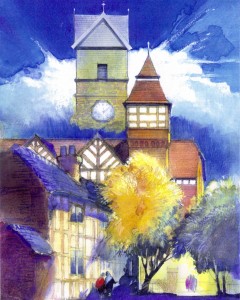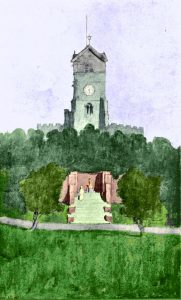
Middleton’s Golden Cluster of heritage has outstanding listed buildings spanning five centuries. Middleton is also characterised by large areas of trees and greenspace. All of this would have looked very different had it not been for Edgar Wood’s activities and commitment to his home town between the years 1890 and 1920.
Edgar spent his professional life trying to reshape Middleton to Arts and Crafts and Garden Suburb principles. He designed over sixty vernacular inspired buildings while also preserving Middleton’s rural heritage wherever possible. His father and brother were local statesmen and through them he had considerable influence in how things developed.
His Middleton buildings illustrate his artistic direction which was at the cutting edge of modern design. Edgar Wood pioneered art nouveau, vernacular revival, Arts & Crafts, expressionistic and art deco architecture roughly in that order. For each, he was ten to fifteen years ahead of the game and in the small modest designs in Middleton, one can see the artist at work trying things out.

Edgar Wood’s designs were so ahead of their time that he had many vocal critics in his home town. His work was scoffed at and ridiculed. He needed to keep a very low profile and continually worked behind the scenes. The name Edgar Wood was especially controversial when it came to publicly funded buildings and there was an outcry when he was chosen to design the Elm Street (now Elm Wood) and Durnford Street Schools in 1905, so much so that they were delayed by two years. The fact that, by that time, he had a national and international reputation meant little his critics.
On earlier publicly funded projects, Edgar remained firmly hidden. The early Arts and Crafts Jubilee Library of 1889 is straight from his very distinct copybook but the design was won in competition by a mature Bury architect, Laurence Booth, with Edgar nowhere to be found. However, Edgar’s father and his main client were the principal funders and judges and it is most likely that Lawrence Booth and the young Edgar worked on it together.
In a similar way, financial and other records show that Edgar Wood restored St. Leonard’s Parish Church in 1905, including designing a new exquisitely carved roof, all under the name of the official church architect, G. F. Bodley. His wealthy step-mother was a member of the congregation and it is noticeable how the church has a unique collection of stained glass by the finest Arts and Crafts practitioners of the early twentieth century. One of two Christopher Whall windows was funded by her and it is hard to imagine how this collection of work could have been commissioned without Edgar’s influence.
Even Edgar Wood’s role as designer of Long Street Methodist Church and Schools was kept a close secret by his small group of supporters until it was impossible for his involvement to be challenged.

St. Leonard’s Church overlooks the earlier Jubilee Library and in 1905, Edgar redesigned the landscape setting of both with a sweeping redesign of the park centred on a grand art deco staircase and drinking fountain, all to set off the church tower. It was Europe’s first art deco design but one completely paid for by his father, thus preventing a public outcry.
When Ye Olde Boar’s Head P.H. was to be demolished to make way for a new Town Hall, Edgar worked quietly behind the scenes and the scheme was eventually dropped. It is now the oldest operating pub in England.
Edgar Wood was also one of England’s pioneering Garden Suburb town planners and a leading light in the new movement. Alkrington Garden Village in south Middleton suddenly appeared as one of the very first Garden Villages in the country. It was exhibited at the 1910 International Town Planning Conference which Edgar helped to organise. The design matches Edgar’s style of planning perfectly yet it has Thomas Adam’s name on it, a planner assisting Edgar Wood’s friends Parker and Unwin in the construction of Letchworth Garden City. It is hard not to suspect that this was yet another Edgar Wood design fronted by a colleague to avoid his detractors at home.
Middleton and its Golden Cluster are thus a major part of Edgar Wood’s legacy. His pioneering architecture, conservation and town planning helped to create an attractive leafy town enriched by ancient buildings and Arts and Crafts architecture.

